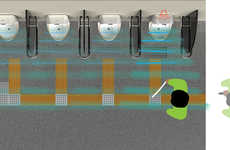
The Braille Staircase Handrail Helps the Blind Navigate Buildings
Amelia Roblin — March 20, 2013 — Art & Design
References: red-dot.sg & tuvie
Taking the stairs should remain an option for the visually impaired and every public set of steps should be enhanced with the Braille Staircase Handrail system. This concept is an ingenious suggestion for installation in all sorts of buildings, especially those without elevators.
Red Dot Design Award winners Bao Haimo, Jin Zhixun, Li Xinyi, Zhou Wenqiang and Li Meiyan propose the integration of three rows of small holes that would line both guardrails. Pegs can be slotted into these and left raised to spell out words that can be read with the fingertips. It's suggested that information regarding apartment building tenants might be described in the Braille Staircase Handrail. Additionally, separate sections could be felt with the right hand to inform the user of the numbered floor to which he's ascending or descending.
Red Dot Design Award winners Bao Haimo, Jin Zhixun, Li Xinyi, Zhou Wenqiang and Li Meiyan propose the integration of three rows of small holes that would line both guardrails. Pegs can be slotted into these and left raised to spell out words that can be read with the fingertips. It's suggested that information regarding apartment building tenants might be described in the Braille Staircase Handrail. Additionally, separate sections could be felt with the right hand to inform the user of the numbered floor to which he's ascending or descending.
Trend Themes
1. Accessibility Architecture - Designing architectural features and structures that accommodate people with disabilities.
2. Inclusive Innovations - Developing solutions that enable access and use by everyone, regardless of their abilities or disabilities.
3. Braille Technology - Advancing technologies that enable the visually impaired to read and write using raised dots.
Industry Implications
1. Construction - Incorporating inclusive features, such as visually-impaired stair railings, into new and existing buildings.
2. Architecture - Designing structures that take into account accessibility for everyone, with features such as Braille staircases and elevators.
3. Assistive Technology - Developing innovative solutions such as Braille handrails that help people with disabilities function more effectively and independently.
3.2
Score
Popularity
Activity
Freshness























